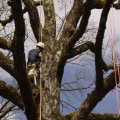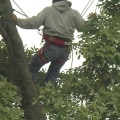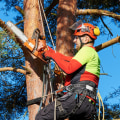An arborist is responsible for the welfare of trees. Implement planting, cultivation, maintenance and removal of trees. They can also be the point of contact for selling trees. The listings below may include sponsored content, but they are popular options with our users.
What is your highest level of education completed? What is your highest educational level? Arborists specialize in growing, maintaining, and removing trees. Future arborists generally need to complete bachelor's degree programs in fields such as arboriculture, horticulture, or environmental conservation. Arborists who apply pesticides to trees must have a license; candidates may consider an apprenticeship with a licensed arborist before obtaining their own license. They can also obtain voluntary certification.
Arborists use hand and power tools to prune, cover, and remove trees. May specialize in keeping trees healthy, planting trees, or landscaping. Arborists can work both in an office environment, designing park designs or planning new plantations, as well as outdoors, pruning and shaping trees. Arborists can specialize as tree trimmers or removers.
Tree trimmers care for individual trees and their appearance by training young trees and removing excessive, dead, or dying branches. Pruners can also use their expertise to select the right tree species to plant based on weather and soil conditions. Arborists can also use specialized knowledge and equipment to remove fallen, storm-damaged, or unwanted trees. According to the BLS, some employers may require aspiring arborists to have a bachelor's degree.
Although few colleges and universities offer a degree in arboriculture, potential candidates may consider pursuing degrees in urban forestry, environmental conservation, and horticulture. Undergraduate programs generally last four years and include courses in botany, plant pathology, and soil science. Some programs may include a mandatory internship at a park, recreational facility, or government entity. Programs generally prepare participants with the knowledge necessary to obtain entry-level jobs and may also qualify graduates for licensing or certification.
Most states require arborists who apply pesticides to pass a state test and provide proof of insurance to obtain a license. Before obtaining leave, new employees receive on-the-job training in horticulture, arboriculture and landscaping. Entry-level candidates can also apply for an apprenticeship position and work with a licensed arborist. Apprentices typically gain knowledge from on-the-job training and can apply for a license when they have accumulated enough knowledge.
Individuals with three years of experience can choose to become certified Arborists, a designation given by the International Arboricultural Society (ISA). Applicants must pass an ISA-administered exam, provide documented experience, and re-certify every three years. ISA offers additional voluntary certifications, such as Master Certified Arborist and Certified Tree Worker. Arborists are tree specialists who can work on pruning or removing trees, as well as raising or maintaining trees.
These positions generally require a bachelor's degree and voluntary certification is available, which can boost employment prospects in some cases. A college job can seem like a simple means to an end, a way to cover your school bills and expenses as you work your way through. By the time you reach your senior year of high school, you may have some experience applying for a job. Applying for unprepared jobs can leave you struggling to get everything together when it's time to submit a.
There are many benefits to getting a part-time job while you're in college, besides earning extra money. A Part-Time Job Can Help You. Start with Southern New Hampshire University Start with Liberty University Start with Harvard University Start with Duke University Start with University of Florida Start with University of Georgia Start with University of Washington Start with Michigan State University. Arboriculture is both an art and a science, creating research-based methods of professional tree care combining physical skill with modern technology.
When it comes to the most important skills needed to be an arborist, we found that many resumes included 12.1% of arborists included CDL, while 10.8% of resumes included hand tools and 7.1% of resumes included customer service. It's helpful to have tough skills like these when it comes to performing essential work responsibilities. If you're interested in becoming an arborist, one of the first things you should consider is how much education you need. We have determined that 45.3% of arborists have a bachelor's degree.
In terms of higher education levels, we found that 4.4% of arborists have master's degrees. Even though some arborists have a college degree, it's possible to become one with just a high school degree or GED. You may find that experience in other jobs will help you become an arborist. In fact, many arborist jobs require experience in a position such as an internship.
Meanwhile, many arborists also have previous professional experience in roles as a cashier or foreman. Tell us your goals and we'll assign you the right jobs to achieve them. Don't have a professional resume? As you progress in your career, you may begin to take on more responsibilities or realize that you have taken on a leadership role. With our race map, an arborist can determine their career goals through career progress.
For example, they could start with a role as Foreman, progress to a position as Supervisor, and eventually end up with the title of Plant Manager. Tell us your goals and we'll assign you the right work to achieve it. Use Zippia's salary calculator to see how your salary matches. Zippia lets you choose between different easy-to-use Arborist templates and gives you expert advice.
With templates, you can be sure that the structure and format of your Arborist resume is top-notch. Choose a template with colors, fonts, &, and text sizes that are appropriate for your industry. Find the Best Arborist Job for You Impress management or get that job with you, your ability to showcase safety practices in the workplace that save lives and money. A short safety management course for current and aspiring security professionals.
In this course, you will learn the fundamental economic theories behind healthcare innovation and how to optimize your own healthcare practice or organization. Designed to help you gain a practical understanding of the theoretical frameworks of behavioral economics and operations management in the healthcare environment, this course will help you apply these frameworks to assess healthcare practices and apply innovation while managing risk. It will also explore best practices for evaluating. .
.






